Interview with Andrew Jenkins about the Taita Falcon
Andrew Jenkins is one of the most prominent raptor biologists in South Africa and has been studying Peregrine Falcons on the Cape Peninsula for more than twenty years. His interest in falcons also extends to other species and he published the first confirmed records of the presence of Taita Falcon in South Africa in the 1990’s and has been involved in the surveying of this population of the species for many years. Andrew established a raptor research programme (Western Cape Raptor Research Programme) at the FitzPatrick Institute, University of Cape Town and has been instrumental in setting up numerous long-running projects. These include population studies on the Rock Kestrel, and Black Sparrowhawk, pesticide studies of African Fish Eagles, behavioural ecology studies of Black Harriers and colour marking studies of Black Eagle. He is also one of the foremost experts in terms of the impact of energy infrastructure on raptors and other birds and currently consults extensively in this regard, in particular with regard to the many wind-power developments planned in southern Africa. Andrew is also the author of many scientific and popular publications and was this year honoured with the Endangered Wildlife Trust Birds of Prey Programme’s Raptor Conservationist of the Year Award.
André Botha
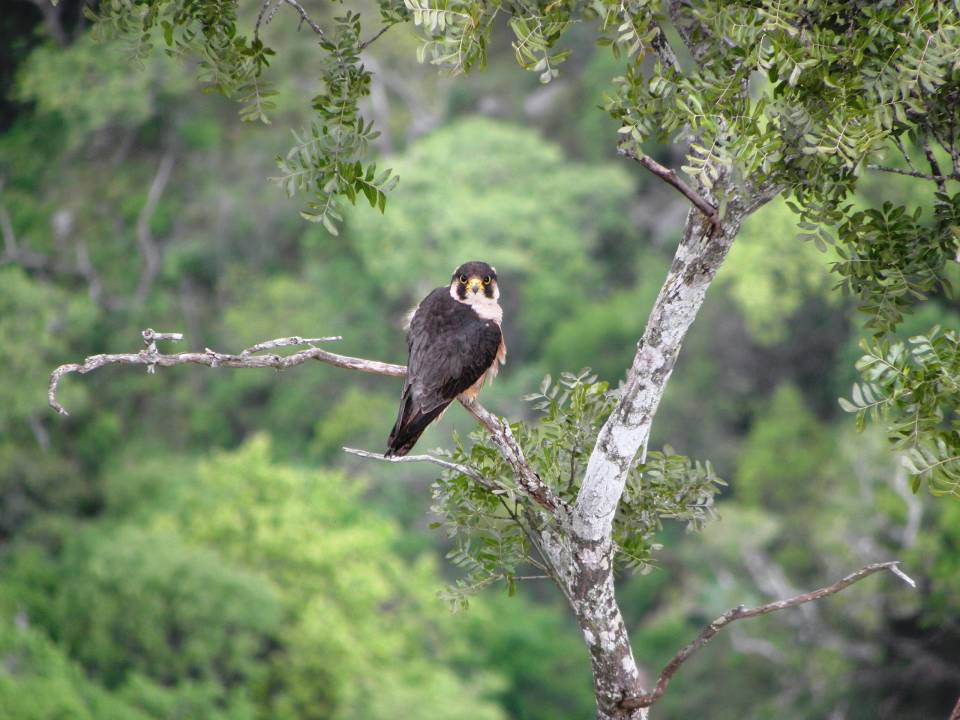
1) What is known about the status of the Taita Falcon across Africa? How many birds are there?
The Taita Falcon occurs down the eastern half of Africa, as far west as the Rift Valley, as far north as southern Ethiopia, and as far south as north-eastern South Africa. This might seem like quite an extensive range, but it is very patchily distributed within this area, in a way that is not presently well understood. Like the Peregrine, it seems to go for habitats that particularly favour it’s cliff-nesting and bird hunting habits – high cliffs in bird-rich areas – but it seems to be much more picky than its bigger cousin. The net result is that its global population is manifested as small, scattered pockets of localised ‘abundance’, sometimes comprising only 1-2 breeding pairs, separated by 100s, even 1000s of kilometers of apparently unsuitable habitat. This impression of patchiness in its distribution may be exaggerated by problems with detecting this small, fast-flying but relatively sedentary species in habitats that are difficult to access, and it has probably been overlooked in some of the less explored areas of the sub-continent. Word has been spreading recently about a number of pairs of Taitas residing on remote inselbergs in the Niassa area of far Northern Mozambique, and we’re hoping to get up there soon to check this fascinating area out.
How many? Well there are substantially fewer than 50 known breeding pairs of TFs on the planet. The jury is out on the actual population, but it is certainly well below 1000 pairs, and probably less than 500 pairs.
2) Has the population changed during the last decades?
We held an informal workshop on TFs at the last PAOC gathering in 2008, at which we tried to collate what we know about numbers and population trends, and figure out what we needed to do to improve our understanding of the status and conservation of this species. An important (if disappointing) conclusion was that we don’t really know enough at present to say anything definitive. However, information from Zimbabwe was cause for concern. The late Ron Hartley, together with an excellent team of local Taita Falcon enthusiasts (many/most of them falconers) spent years studying this species in Zimbabwe, and most of our current knowledge of the biology of the Taita Falcon stems from his surveys and observations of the Zim population. I think Ron knew of up to 16 nest sites in Zimbabwe, and suspected as many as 50 pairs were resident in the areas he and his team frequented. Since Ron died, Neil Deacon and others have done their best to keep tabs on at least some of the Taita sites in Zimbabwe, and their take on the current situation there is not encouraging. A high percentage of Ron’s known territories are no longer occupied, and even the long-established stronghold at the Batoka Gorges below the Victoria Falls has apparently dwindled from six known pairs to only one, and the species reportedly hasn’t bred successfully there for over a decade.
Similarly concerning information has come out of Uganda, with the four pairs reported from Mt Elgon in the 1980s apparently no longer there. The data to hand are by no means conclusive, and survey effort was almost certainly greater in the past than what is being brought to bear now, but indications are that the Taita Falcon may have decreased in some areas of its very sparse central African range. In contrast, we have done some quite intensive searching for these birds in South Africa in the last 5-6 years, and have managed to bump our known population up from two pairs (the first of which was only discovered in the late 1980s) to eight. In fact, we have found enough pairs to question whether these birds could possibly have been missed in raptor surveys conducted by some pretty heavyweight observers 30 years ago. The Taita Falcon is not the sort of bird that I would expect to exhibit quite sharp changes in distribution and abundance, but some of the evidence to hand, particularly from South Africa, suggests that such fluctuations might occur.
3) What is the preferred habitat of the species?
Good question! It is an obligate cliff-nester, and certainly likes big rock faces, although it is by no means restricted to only very high cliffs. It is also linked somehow with woodland habitats, with a penchant for dry woodland, and an apparent dislike for cliffs overlooking forest. Beyond that it’s difficult to say. My personal belief is that the Taita Falcon is a highly specialized predator that depends on habitats with a very particular structure and/or avifauna in order to make ends meet. Quite what that habitat structure might be I’m not at all sure. Ask me again in 10 years time!
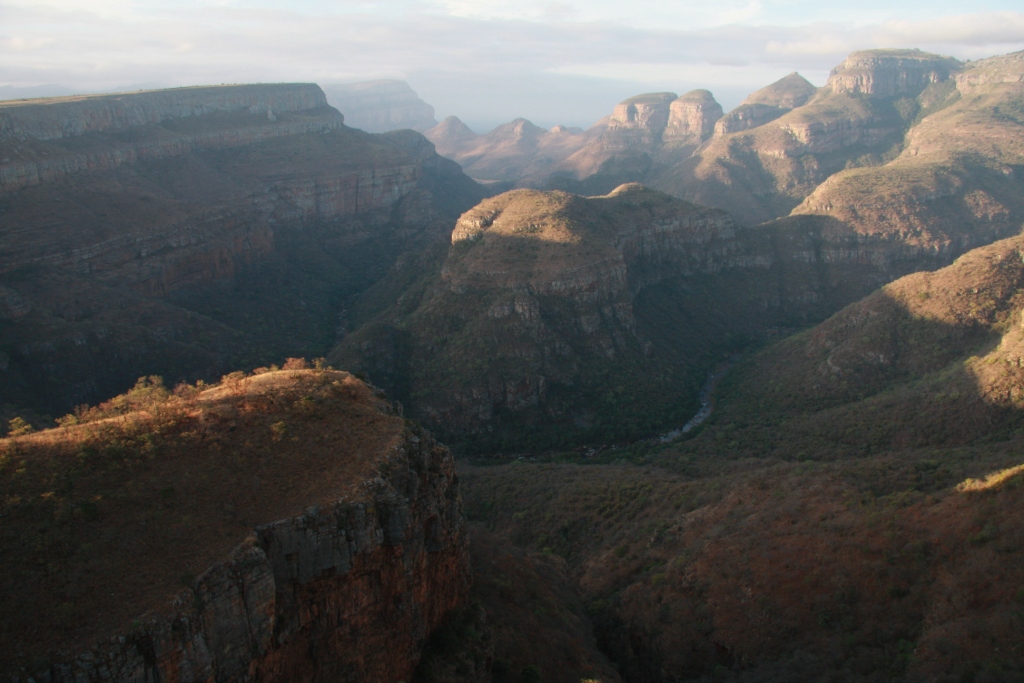
4) What is the preferred prey of the Taita Falcon?
Small birds. The literature would have you believe that it is a major predator of aerial insectivores (swallows, martins and swifts), and this is surely true in some areas, but has not really been our experience in watching Taitas in South Africa. We spent some time last summer watching pairs provisioning newly fledged young. They were under pressure to perform and, in some cases at least, operating on cliffs with thriving swift and swallow populations on and around them. We saw lots of hunting, but not one confirmed strike at an aerial insectivore, and only one delivered prey item that could possibly have been a swift. We struggled to identify what they caught and brought onto the cliffs, mostly because each item was so small and so rapidly processed. Red-billed Quealea came up a few times (even though we saw none in the local environment), and a possible Tambourine Dove. I’d be surprised if they took anything bigger than 80g with any regularity.
5) Is there a difference in prey size taken by males and females?
I really couldn’t say for sure, but the species is certainly sexually dimorphic enough to suggest that there is, and we’ve indications of this at the nests we’ve spent time watching in SA.
6) How do the birds hunt? Do they also hunt in pairs?
They are very fast and, like other large falcons, use speed as their primary means of surprising and catching their prey. They have an extremely chunky build, very short tails, and very hard, inflexible plumage. As such, they are built for high speed operation, even more specialized in their construction than the Peregrine. I’m not sure that they fly faster than Peregrines, but they certainly exceed them in terms of the frequency with which they fly fast, which is pretty much all the time!
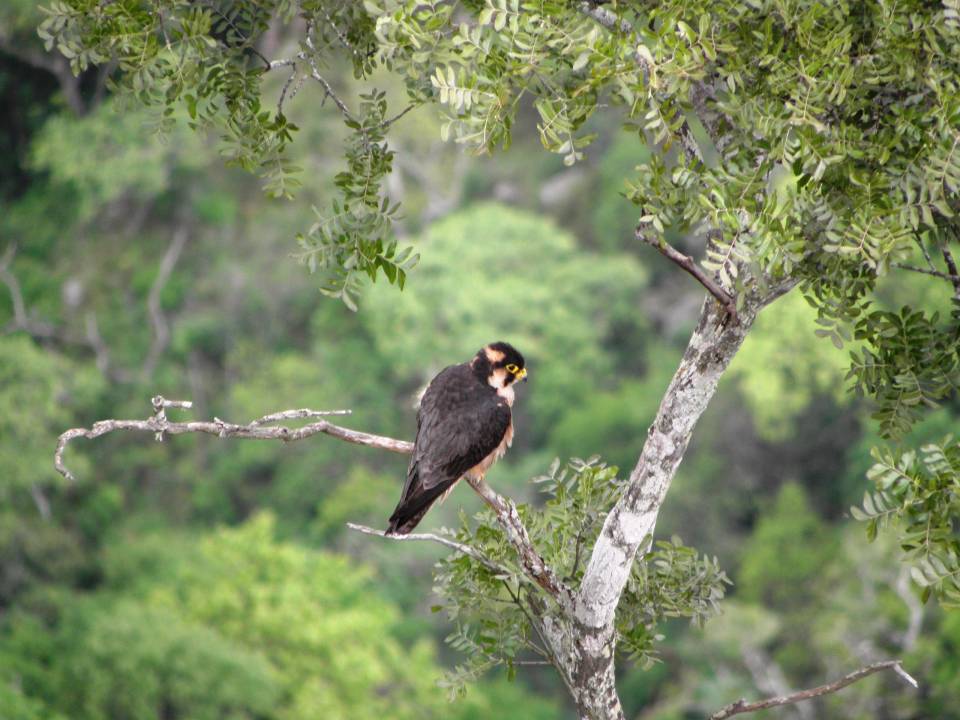
I think they occupy very small foraging ranges, but they can work those small areas very hard. Much of their chunkiness comes from massive pectoral muscles, which they use to generate a very high wingbeat frequency, getting them from A to B in double quick time even when there is no wind to hold them up. When the wind is blowing, to me they become quite buoyant flyers. Clearly they have a very high wing loading relative to their size, but in absolute terms they can use even moderate winds to huge advantage. They have a very interesting wing shape, with shortish outer secondaries just like a Peregrine, but then unexpectedly long middle primaries. The net result is a curiously blunt-ended, boomerang like outline, which must have some aerodynamic significance – perhaps it confers more forward thrust on the downstroke of the wingbeat? Coupled with an almost non-existent tail, the Taita is certainly a departure from the standard large falcon design. Understanding the function of this odd shape may be key to understanding the constraints within which this bird operates, possibly unlocking the secrets of its weirdly patchy distribution?
Given what I’d read about them before I started watching them, I expected Taita Falcons to hunt mainly in the high, open sky. This is where swifts like to ply their trade, and I figured the Taitas would get up there with them and hunt them down. This might well happen, and certainly the bird has the look of an effective swift hunter, but the Taitas we’ve watched on the Mpumalanga escarpment seem to hunt the woodland below their cliffs much more often than the wide open spaces in front of them. They are incredibly adept at snatching small birds from just above the tree-tops, in a way that I have never seen Peregrines or Lanners even begin to contemplate.
Yes, they hunt in pairs, but I would be surprised if they did so in a truly cooperative way. From the little I’ve seen, just like Peregrines, members of Taita pairs target the same bird at the same time, and may increase their chances of success in doing so, but there is little or no division of roles, and no sharing of the spoils afterwards.
7) What is the average breeding success of Taita falcons?
Not what you’d expect in a bird of this size. All other things being equal, allometric theory would predict that the much smaller Taita would lay larger clutches of eggs and fledge bigger broods of young than either Peregrines or Lanners. In reality this is not the case. The data are few, but four egg clutches are no more frequent in Taitas than in Peregrines, and they probably fledge smaller broods on average than Peregrines, and appreciably smaller broods than Lanners. So even though they are much smaller than sympatric congeners, they seem to be slightly less productive.
8 ) Is there competition with other raptors, for example Peregrines?
All indications are that they may struggle to co-habit with other, larger falcons. Certainly Ron Hartley noticed some Zimbabwean Taita sites apparently turning over to Peregrines or Lanners, and Kit Hustler noted how the Taitas in the Zambezi gorges near Victoria Falls were subordinate to Peregrines, and moved their nest ledges in response to changes in the location of Peregrine sites. However, in terms of their respective resource requirements, I think that there is probably quite good niche partitioning between the three species, and given the marked size difference between Taitas and the two bigger birds, I’d say there was less scope for active competition between them and either Peregrines or Lanners than there is for competition between Peregrines and Lanners. I suspect that the problem for the smaller species may be more about domination and possibly even predation by the larger falcons, than it is about competition per se.
9) What is known about movements of the falcons and dispersal of juvenile birds?
That’s an easy one – nothing. I think it’s probably fair to say that territory-holding adults are strongly centred on their nest cliffs and the immediate surrounds throughout much of the year. There must be some relatively long distance dispersal of young birds and non-breeders in the ‘floating’ population in order for the various small populations to remain genetically in touch, and records of injured birds being picked up a long way from any known nesting areas support this notion.
10) Is the species affected by pesticides?
As a close relative of the Peregrine – a species that seems particularly adversely affected by pesticides and chemical pollutants, there is always the chance that the Taita Falcon could be susceptible to these substances too, and we would be remiss in not considering this factor in our efforts to conserve the species. However, given that Taitas typically use habits situated away from intensive agriculture, and probably take prey less likely to ingest toxins than Peregrines, they may be less easily exposed to chemical contamination.
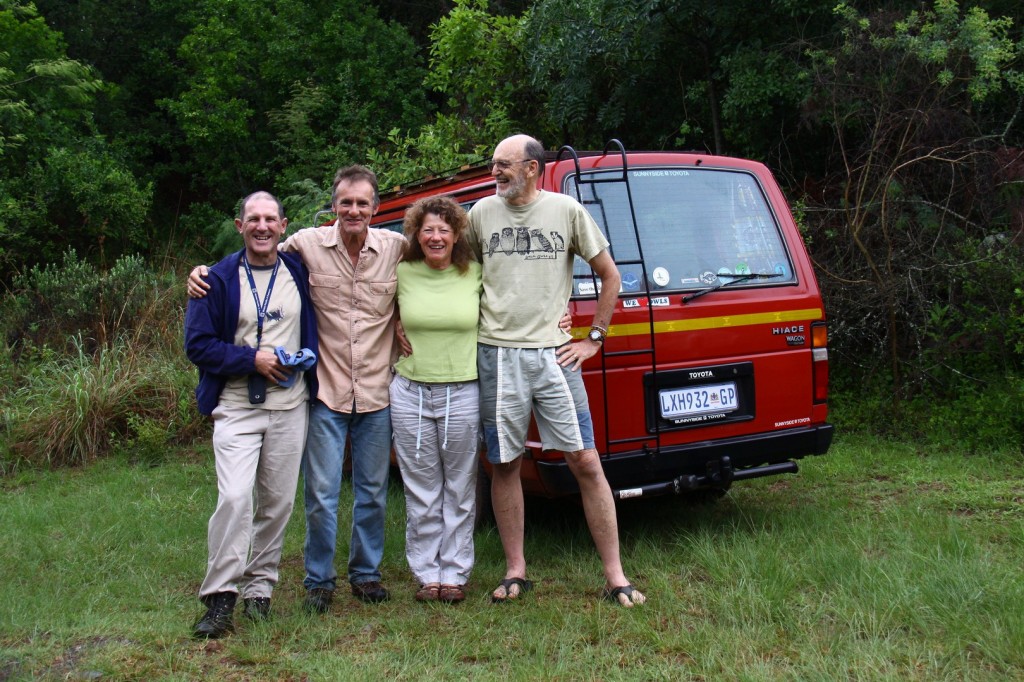
11) Are the birds illegally hunted for falconry?
I’m not sure that ‘hunted’ is the right term – harvested maybe? – and while there have been a couple of iffy incidents at one nest site in South Africa (and doubtless elsewhere too), my perception is that the Taita is not a species in high demand by serious falconers. It is too small and too specialized for classic falconry. While there seems to be some interest in trying Taitas as falconry birds (and this has been done to a limited extent quite legally in both Zimbabwe and the US, using captive bred stock), and perhaps a little more interest in captive breeding and hybridizing the Taita with other, larger falcons, I don’t think falconry – legal or not – poses a significant threat to the conservation status of the species.
12) What other threats do exist for the species in Africa?
I doubt that there are any clear and overriding factors. Rather, the very sparse nature of the Taita’s distribution, its very particular habitat requirements, and its small aggregate global population, make it vulnerable to a wide variety of factors on a localized basis. For example, small populations of fewer than 10 pairs may be affected by a highly location-specific variable – e.g. disturbance by adventure tourism at Victoria Falls, habitat loss to rural development around the Mpumalanga escarpment or to elephant overpopulation in the Zambezi valley, or pollution or impoundment of key river systems. Any such mechanism could quite quickly render previously high quality habitat unusable, resulting in localised extinction of the species.
13) What needs to be done to secure the future of the Taita Falcon?
I’m a great believer in the need to understand a species before planning a strategy for its conservation; in knowing how many individuals or pairs there are out there, getting a bead on current numerical trends, and developing a working understanding of the key resources which underpin the birds’ survival. Right now, I’d say that we are generally ignorant of most of these aspects of Taita Falcon ecology and biology. We need to learn more about the species, its requirements and its problems before we can hope to secure its future.
14) Are there any conservation projects for the Taita Falcon?
At the moment we are trying to learn more about the Taita population in South Africa – we (the South African Taita Falcon Survey Team – core members Anthony van Zyl, Lucia Rodrigues, Alan Kemp and myself) conduct annual surveys of the breeding pairs we’ve located in the Mpumalanga escarpment area, survey the area for new pairs, and we have recently started looking at breeding success, diet, hunting behavior and provisioning rates. To the best of my knowledge, this is the only funded research or conservation project on the species underway at present, and it is very small scale – amounting to not more than a couple of weeks of field time annually. In the past, This work has been sponsored by The Peregrine Fund, as well as by the African Bird Club, the Endangered Wildlife Trust, Birdlife South Africa and Glendower Whisky. We recently signed up with BirdLife SA/International as Species Guardians, and hope to tie our work with more opportunistic work being done by Simon Thomsett in East Africa, Neil Deacon and others in Zimbabwe, to develop a more Pan-African picture of the Taita’s status.
15) Can bird watchers visiting Africa help, for example by sharing their observations of Taita Falcons outside the known territories?
This is a difficult bird to see, and there are issues with identification, but any reliable Taita Falcon sightings, pretty much from anywhere except the very best known sites for the species, would be extremely useful.
16) What was your most amazing experience with Taita Falcons?
There have been a couple of memories that stand out. I guess the main reason I love watching falcons is the incredible speed and precision of their flight, and I remember watching at a Taita site near Blyde River Canyon with the rest of the SA survey team a few years ago wher we saw a great example of this. The birds we were monitoring were incubating at the time and the female was tucked out of site at the nest ledge. It was late in the afternoon and there was some weather blowing in onto the escarpment, the horizon looking dark and stormy, and the wind rushing urgently over the cliff-top. The male Taita was on a mission, riding the coming storm with irresistible energy and sizzling velocity. In an instant he transformed himself from a small, dense speck hanging in the sky, pinned against a curtain of grey looming over the Drakensberg crags, to a blurred flash of russet, scorching across the rock face then surging upwards again into the brooding heavens. He repeated this circuit several times. As observers, all we had to do was stand still and follow him in our binoculars as he described giant arcs in the air above and below us. And yet we struggled, left dazed and confused, losing and searching for him again and again as he jetted on his way.
Another memorable moment occurred later in the breeding season. Anthony van Zyl and I had hiked up under a known site in early December to check breeding success. We had waited on the slope below the nest cliff all morning in thick mist and rain, hoping that the cloud would lift and our patience would be rewarded. Around midday the weather brightened, and quite quickly we had a view of the cliff. As visibility steadily improved the Taitas came to life. It seemed that they had been waiting as expectantly as we had, and the scratchy whining of at least two newly fledged youngsters became more and more urgent. In response, the adults got airborne and started hunting, soaring in front of the cliff which was now completely clear of cloud. In the next 40 or so minutes we saw six strikes, most if not all of which were made at small passerines over the dense woodland immediately below the cliff, and all of which were successful and resulted in prey deliveries to the brood. There was absolute chaos on the cliff, with the two chicks receiving an obscene glut of food. At one stage we watched a youngster mantling over her second meal in ten minutes, as her father tried vainly to ply her with a third! We learned for ourselves that day what others have noted before us: that under the right conditions the Taita is a highly efficient hunting machine. And, as others have done before, we were left wondering why it is not more widespread and successful in the Afrotropics?

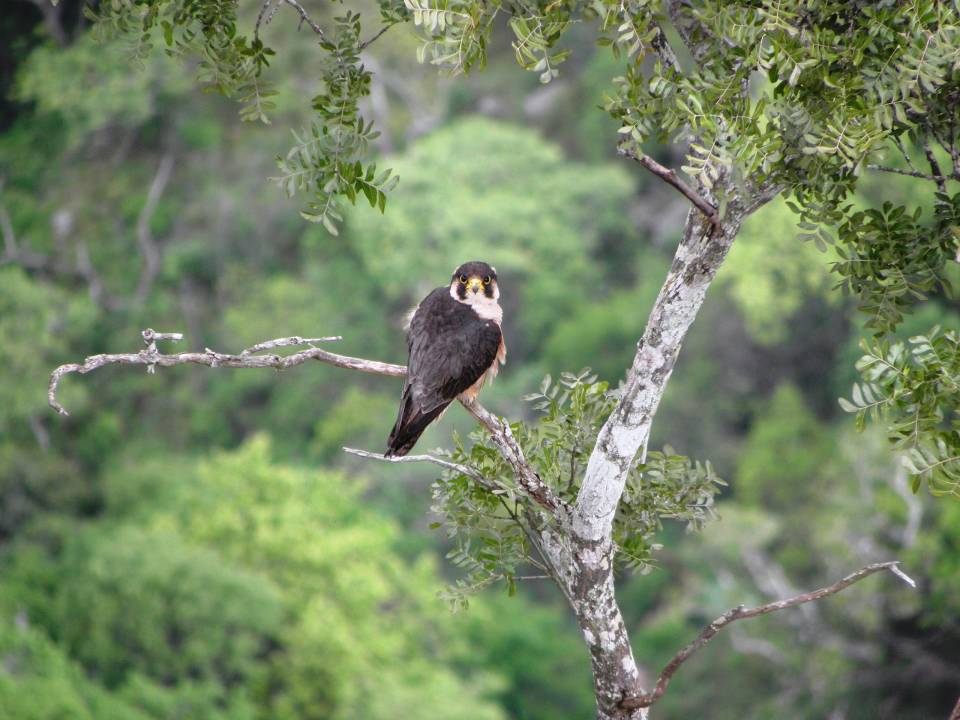
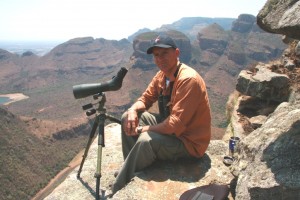

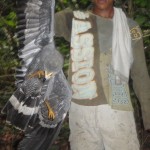

Thanks Markus, a highly informative and interesting interview.
I’m involved in MSc research in New Zealand, looking at the dispersal ecology of the rare endemic NZ falcon – not as threatened as the Taita, but just as cryptic and many similar issues in deficiencies in knowledge. Are there any captive breeding release initiatives with this species?
remarkable article, May I suggest a way of detecting taitas, which will be the use of a trained buzzard to attract agressive responce on potential good sites.
have you thought of fitting offsprings with transmitters?to survey the dispersion?.
please keep posting on this fascinating subject
best regards and congratulations to the team
I discovered the first live Taita Falcon in Malawi on Chipata Mountain on 14th May, 1976, confirmed later that year by Dale Hanmer, who had 3 circling above her head at 6am. (Con Benson had a dead Taita brought to him in Mangochi in March, 1933) These birds were the basis for declaring the Nkhotakota Wildlife Reserve an IBA.
According to the Dowsetts, the site has unfortunately since been taken over by Peregrines.
Last month I visited the breeding site of another pair on an inselberg north of Mwanza on the Mozambique border, which had been discovered in Nov. 1977 by the late Malcolm Douglas, and confirmed by Nigel Hunter, Dave Stead and Vicky Taylor. The birds are still there! There are one or two other sites in Mwanza/ Neno which have the look of Taita Falcon nesting sites, and where I thought I saw a Taita, but I have not yet had the oportunity to confirm. The area has many inselbergs, as is the case over the border in Mozambique.
Thank you for this VERY interesting account!
Astounding article. It is like getting a fully detailed photo of an unseen entity. I have great interest in Taitas, it parallels my interest in Bat Falcons and Orange Breasteds, which are the only peregrine-like species that occur in two sizes in an eco-system. I think this same situation is exemplified by the Black Shaheen and the Oriental Hobby in Asia. The well known American falconer Hans Peeters feels there may be a similar relationship between Taitas and Red Shaheens. Thank you so much for the wonderful work you are doing. I look forward to seeing your work in the future and would welcome any updates or correspondence in the meantime.
Andrew, great write-up and well done for all the hard work of getting to know this elusive species. Your insights on falcons and flying morphology are fascinating and make sense. Do you think the wingshape (well described as boomerang shaped) is a mirror of its principal prey species, swifts? They do seem to travel so fast, maybe it looks that way because they are smaller than peregrines. I was struck by the huge smooth arcs of their stoops. Your observations have done a lot to take the mystery out of this bird in its relationship to its habitat and this goes some way to answering the question that you pose at the end. Thanks and please let me know when you are going to Niassa!
Great interview with many insights.
I watched Taita Falcons hunting regularly at Victoria Falls in the late 1990’s. They targeted flocks of weaver like passerines (mainly Red-billed Quelea) and did not hesitate to fly through the flocks in their efforts to catch prey. Mostly done from a high stoop, but then the gorge there did not encourage any perch hunting. I did not see them attempt to catch any swifts at all, in spite of soaring in large flocks of them on a regular basis. One of the pair closest to the falls disappeared and the other remained on the nest cliff for a while, before it also vanished. As far as I know, no Taitas have been seen there since. There are many claims, but they always turn into Peregrines under close scrutiny. The reasons for their rarity remain as elusive as ever and all the more reason to monitor them. My guess is that they are fairly scattered throughout the woodlands in central Africa – there is a reliable record from a cliff only about 15 m high (max) on which they attempted to breed. They were there for a couple of years and then moved on.
Keep up the good work.
Hi Andrew,
Great paper and input on the Taita falcon. Thanx.
Paul Venter
I had an incredible experience on Tuesday 13 January when, whilst in my Garden, a Taita Falcon chased a Cape Bulbul into an olive tree (very bushy) and settled for about 5 minutes as he missed his target. I was able to kneel within 2 metres of the Falcon and observe him at close range, He was unmistakably a Taita Falcon and I was able to identify the diagnostic markings of the small size, rufous body, white throat, mustachiod markings, yellow ring around the eye, slate grey back and head, yellow legs.
Unfortunately I did not have my cell phone on me so could not take a photo. So I sat with the Falcon while he was checking out the dense olive bush looking for the Bulbul which he spotted aftyer a few minute and made an attempt to flush him out of the foliage. The Bulbul was literally screaming in alarm but remained in the bush. All of htis took place within 2 metres of where I stood. It was an electrifying experience. The Falcon gave up and flew away over our fence wall into the valley in Hout Bay where we live on the side of the mountain.
Naturally, I pored through all of my bird books and confirmed my initial observation that it was indeed a Taita Falcon.